It is difficult to find the flower bed in Russia or another CIS country, where there would be no velvetsev. These American guests loved to our gardeners and simply lovers of colors that became an integral part of any landscape design.
These flowers can rightly take the first place for unpretentiousness in planting and care, the velvets is also famous for their beauty. Putting the velvets on its plot, you will get colorful and fun flowers that will delight you with your lush flowering to the most frosts.
In this article we will look at the features and detailed description of the velvetsev, and also learn about the most popular and common types and varieties of these bright colors. In the second part of the article, we will tell about the main nuances of the agrotechnics of growing the flowes of velvetsev.
Features and description of the velvetsev
Velhets - plants that relate to a large family of comprehensive or astera. This type of flowering plants is a representative of garden colors, although they can also be grown on balconies and loggias. The velhahattsy is also called Tagtess, which refers to ancient Roman mythology. Such a name gave them a scientist Karl Linney. Tagtess is the name of the grandson of God Jupiter, who knew how to predict the future and was very beautiful. So the flowers of the velvets are striking all their uniqueness and bright appearance. The name "Velhets" transmits the color palette of these colors and gentle on the touch surface of the petals. In the people, sometimes this culture is called Chernobriv.
The homeland of these popular colors is considered the territory of South and Central America. It is here in nature that you can find the greatest number of species of this flower. However, from the mid-16th century, the velvets spread throughout the world. In Russia, these flowers became the first to go to the country with blooming plants. To date, the velvets are among the most popular colors that are found on the flower beds in all corners of the globe.
Description of the velvetsev:
- Velhets are grassy blooming plants, which in shape resemble small bushes with strong and rather thick stems and branches.
- In height, these flowers may be different, it all depends on the specific type and variety. There are specimens that are in height reach 1 meter and are perfectly suitable for flower beds and single landings. There are also many varieties of low-speed velvets, which look perfectly in balconies or in containers on the plot. The average height of the flowering bush can be from 10 cm to 130 cm.
- The stalks of the velvetsers are reprehension or branched, which allows for the form of a beautiful and compact bush. All branches are strong and thick.
- Leaves in this culture may also be different. There are peristo-separated and periodically dissected. In color, they vary from light green to dark green.
- The velvets differ in the urine root system.
- Inflorescences are represented in the form of strong and dense baskets of all kinds of colors. Velhets are often found all shades of yellow, orange and brown.
- The flower itself consists of mid-colors and edges. In the middle, they are tubular, and along the edges are already petals.
- In the form of flowers can be simple and terry. On one bush there are several blooming baskets.
- Barchatz bloom for a long time, from the beginning of summer and to the first frosts.
- After biting on bushes, fruits appear with seeds in the form of a linear seed.
- The main feature of the velvetsev is high similarity. Very often, the seeds are independently scattered and the next year the young shoots of velvetsev appear.
- All types of velvets have a specific resistant smell, which proceeds mainly from the leaves. It allows you to scare from pests from flower beds.
- Velhets are widely used in folk medicine.
Popular species and varieties of velvetsev
To date, there are about 60 varieties of velvetsev. But on the territory of Russia and the CIS countries, only a few most popular species of velvetsev are most often found. Read more consider their features and the most frequently grown varieties of velvetsev.
First of all, all velvets can be divided into the structure of inflorescences:
- simple - all petals are located in one row and resemble a chamomile;
- semi-grade - such inflorescences consist of 2-3 row of tongue petals;
- terry - are formed using a variety of rows of tubular and tongue petals.
All velvets can also be divided into groups depending on the height of the bush:
- dwarf - height reach 10-15 cm;
- low-speed - 20-40 cm in height;
- average - height can grow by 40-50 cm;
- high velvets - 60-90 cm in height;
- giant - 90-130 cm.
You can also allocate velvets perennial and annuals.
Most often in Russia, three varieties of velvetsev are grown in Russia: velvets are straightforward or African, barchatts rejected or French, velvets Throughly or Mexican.
Velhets Personnection
- These are representatives of annual plants, which can be in height to reach 30-120 cm.
- Depending on the height, used to create various garden compositions. Can be grown in containers, flower beds, on the flower beds. They can also be used for cut.
- This kind of bushes with thick and strong stems, which is very branched. At the base of the bush was a weird.
- On the stems, the arristo-separated leaves of light green or dark green leaves are located.
- Baskets of colors have a spherical shape and are presented for mostly terry inflorescences. Mostly all the colors of monophonic shades, from yellow to saturated orange.
This species one of the most common in our gardens and flower beds, as it has unpretentiousness and resistance to rather low temperatures.
Popular varieties:
- Antigua. Inflorescences in diameter 8-10 cm yellow or orange color. They are low colors, height can reach only 20-30 cm.
- Kilimanjaro. This variety of velvets is white with a cream grades of inflorescences. Height reaches 70 cm.
- Eskimo. It is also a representative of the velvette with white colors. Unlike Kilimanjaro, is a low grade.
- Aztek Lime Green. Velhets with a very unusual color shade - Lyamovo green.
Barchatts rejected
- This type of velvetsev is distinguished by rather small flowers, in diameter that can reach only 4-8 cm.
- The species received its name due to the presence of the bush with dense stems of lateral rejected shoots. It is these shoots that make a bush more spread.
- In the height of the veleant of this species can reach different heights. There are varieties of dwarf velvets, low and high. Depending on the height, it is necessary to determine the optimal landing site.
- Most often, the velvets rejected are two-color, in the middle of yellow, and on the sides of the shade can be different - from yellow to red.
The velvets of this species are also very popular among Russia's flower products, as they are distinguished by enviable resistance to our harsh climate.
Popular varieties:
- Carmen. The low-spirited variety of velvets, height can reach only 20-30 cm. Inflorescences are small, whose cores are yellow, and the edge petals of reddish brown.
- Queen Sofia. They differ in red petals that have a weak shade of bronze along the edges. In the form of inflorescence is weak, just one row of petals.
Barchatic velvets
Less common type of velvetsev, but their appearance simply amazes. They are very different from other varieties.
- Buckets are more branched, height can reach only 40 cm.
- One of the main decorations is openwork narrow leaves, among which the scattering of small inflorescences can be seen.
- Flowers of thincase velvets in the form of simple, very much resemble multicolored daisies. They are very small, only 2-3 cm. However, there are a lot of them on one bush.
- There are varieties with yellow flowers, orange, reddish yellow and reddish-orange.
Popular varieties:
- Red gem. Velhets with red petals around the golden yellow core.
- Dwarf. Low bushes on which in large quantities blooming bright yellow inflorescences with a red core.
- Lemon Jam. Low velvets with yellow shade flowers.
Methods for breeding vertexes
Perennial and annual marigolds can be divorced in the site using seeds. For this purpose, you will have to purchase seeds in specialized stores, but in the future it will be enough will be autumn after flowering to collect the velvetse seeds. However, remember that most of the hybrid varieties when disembarking collected seeds lose their properties. And you can get a plant, different from the picture on the packaging with seeds.
It is possible to dilute independently the velets by sowing seeds directly into the ground and with the help of growing velvet seedlings. The choice of one of the two ways depends on many factors: climatic conditions in your area, temperature at night, May freezing, the desired time for getting flowering bushes.
Sowing seeds in the ground
Seen the marriage seeds in the ground can be mainly in southern territories, wherever the probability of return freezers and the night temperature does not fall below 7 degrees of heat. The optimal time for this end of April-beginning of May. But in this case it is necessary to keep in mind that the flowering plant you will receive no earlier than in 2 months.
- Be sure to prepare the ground under the landing. The velvetsev is acceptable to use nutrient soil.
- Seeds can be seen immediately into the ground, and you can use germinated. This is how experienced flower flows do. To germinate seeds, place on a small and shallow saucer, cover with a damp cloth and wrap into polyethylene. Next, put them in a warm and sunny place. You can on the windowsill. After about 3 days, your seeds are scored and you can soak them.
- Seed seeds need in small wells, a depth of 4-5 cm or make a shallow groove.
- Seeds need to be heated at a distance of each other so that the plants develop in the future well.
- Further, all the wells or grooves need to sprinkle the earth and ride a little water.
- In the future, after the emergence of young seedlings, they need to be frozen, leaving the strongest and healthy.
Seeding seeds
If you want to get flowering plants much earlier, you can sow the seeds of the velvetsers to seedlings.
- Seed seeds in seedlings can already be at the beginning of spring, in March or April. Then you will get the flowering bushes of the velvetsev in June.
- First prepare the nutrient soil for planting. It should consist of humus, peat, sand and turf.
- On the bottom of a suitable container, place the drainage layer so that young seedlings do not start. As a drainage, use small stones, clayzite or broken brick.
- Next, the drainage pour the soil and prepare the grooves for seeds.
- Seeds before planting can be disinfected by manganese.
- Seeds are sown to a depth of 2-3 cm, the distance between them should be at least 2 cm.
- Sprinkle neatly grooves of the ground and a little water water.
- Put the container with the seeds to the room with a permanent temperature of 25 degrees. In such conditions, the seeds will warm on 3 days.
- Further until the seedling seedlings in the open ground, the container must be in a well-lit room, but not on the outdoor sunlight.
- Care consists in regular irrigation and ventilation.
- After the appearance of three leaves, all seedlings need to dive.
- It is possible to plant seedlings to open ground in the middle or late May.
Stages of preparation before boarding the velvetsev in open ground
To obtain beautiful and lush blooming velvets, you need to carefully prepare. It is important to get a strong and healthy seedlings, choose a suitable place for flower beds with velvets and prepare the soil under the landing.
Selecting planting material
If you decide to raise the velvet seedlings on your own, then it is important to choose the right time for this. For each type of this culture, sowing seed seeds will be different. Previously, all the seeds of tall velvetsev are seeded - about March, and in April, seeds of low-spirited varieties can be sang.
You can also buy veciatts in the finished form in any specialized store or nursery. Usually they are sold in the form of seedlings planted in separate containers. In this case, carefully inspect the planting material. It should not be damaged, seedlings should be strong and healthy.
Selection of places for landing
The velvets are considered one of the most non-additive plants, so they can grow almost anywhere. To get a beautiful and blooming bust of velvetsev, it is best to choose a well-lit place. This culture does not make shadow and too wet soil. If you have a garden, the velvets can be planted between the ridges with vegetables. With its smell, these flowers scare the pests.
Velhets can be planted on flower beds, in containers, as well as in pots on balconies.
Soil preparation for landing
Velhets will grow well on thin nutrient soils. It is important for these flowers that the soil is air and loose, and also missed water well. Before boarding, it is necessary to switch the selected plot to the bayonet shovels and add complex mineral fertilizer to the soil, mixing well with the Earth.
Landing seedlings of velvetsev outdoor ground
In the middle of the end of May, when the threat of return freezers passes, you can proceed to landed seedlings in open ground.
Landing of velvetsev:
- Soil for landing should consist of humus, sand, peat and a turf. It is important to add mineral fertilizers to it.
- At the selected area, prepare the landing wells. Their depth must be 2-3 cm so that the seedlock can be opened by about 2 cm.
- The distance between the wells depends on the variety of velvets. If you plan the tall velvets, then the distance make 40 cm, the lowered - 30 cm, dwarf - 20 cm.
- At the bottom of each well, it is necessary to place a layer of drainage from crumbs or small stones. It is necessary to prevent water stagnation at the root system of colors.
- Next to each well gently place seedlings and sprinkle their land.
- After landing and within a few weeks, the velvets need constant watering.
Features of the care of velvets in the open soil
Caring for the velvets after landing does not require special efforts and costs. It consists in periodic watering, soil looser and feeding. The cultivation of velvets is so simple to occupy that any inexperienced gardener will cope with him, even if he has never been engaged in planting plants.
Watering vechatsev
Velhets need moderate but regular irrigation. Special attention to watering should be paid during the active growth of the plant. During this period of water, bushes need more. However, with the beginning of flowering, the amount of irrigation should be reduced, otherwise you risk pour roots. And from this flower can start rotting. In the summer, especially in a dry period, watering is better spent in the evenings.
Loosening vertexes
This is an important stage of carchatse care during the entire period of growth and flowering. This culture needs loose and air soil, because the root system should breathe. It is also periodically necessary to remove weeds so that they do not interfere with the growth of velvetsev.
Undercaming Barhetsev
Fucking the velvetsev is not a major requirement to care for these plants. However, if you want to get a beautiful and lush plant, you can make any fertilizer, except for manure. All feeding can be divided by three times. The first time fertilizer is brought during the growth of the plant, the second can be carried out when the first buds appear, and the third is before the blossom. It must be remembered that too frequent fertilizers will slow down the flowering of velvets. Complete mineral fertilizers are best suited for fertilizer.
Trucking vertex
To give bushes of velvetsev beautiful shapes can be triggered. This is usually done in the summer. Be sure to cut faded buds of colors. Thus, you will strengthen the total blossom of velvetsev. In addition, the appearance of new buds is possible.
How to collect velvetse seeds
If you planted the velvets for the first time with the help of seed purchased, then next year you can easily use independent seeds. On a strong and healthy bruise of velvets, choose several buds and allow them to dry well. After that, collect all seeds from them. They can perfectly be preserved until the next spring. However, consider that when landing such seeds, you will most likely get some other velets than the parent plant. This is due to the fact that all velvets are hybrids.
Fighting pests of velvetsev
Many diseases of the velvets saves their specific smell. It helps protect not only the flowers themselves, but also next to growing vegetables and plants.
However, due to improper care, some problems with the cultivation of velvets may appear:
- The appearance of slugs and snails. These pests may appear during rainy periods. To prevent such a case, you can place in all the flower bed with a chlorine container. If you saw slugs and snails on the ridges, it is best to clean their hands.
- Cute tick. It can also appear on the velvets during a wet weather. To combat it, you can use special preparations or folk recipes for solutions, such as yarrow and onions.
- Gray rot. If the irrigation mode was broken, the plants may appear gray rot. This disease is very serious and is difficult to be treated. The infected plant should be completely removed and burn, otherwise you risk losing others.
Using velvets in landscape design
Velhets are an excellent option for decorating any site. These are flowers that long will delight bright and lush flowering. Depending on the specific variety and height of the bush, the velets can be planted along the garden tracks and along the edge of the flower beds (lowered), as well as in the center of the flower beds (tall). Many gardeners recommend landing velvets along the perimeter of vegetable garden and beds with vegetables. Thus, you protect your crop from pests, which scares the smell of velvetsev.
Dwarf and low-spirited velvets can be planted in containers in balconies.
Stock Foto Velhets in landscape design
More clearly to see all the features of the use of velvets in the gardening of the site can be on the presented photos.
Using velvets for the design of balconies
Garden composition with velvets
Growing velvets in containers
Make your site bright and beautiful without problems with the help of solar vertices. These flowers will not require you a lot of time and effort, but in response will delight with beautiful and lush ups with a lot of fragrant colors.

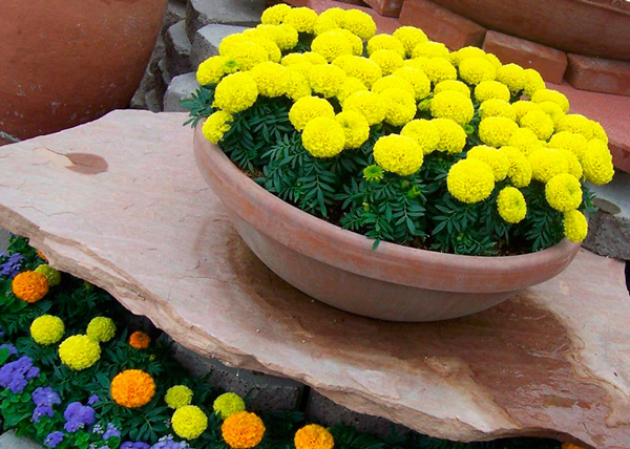
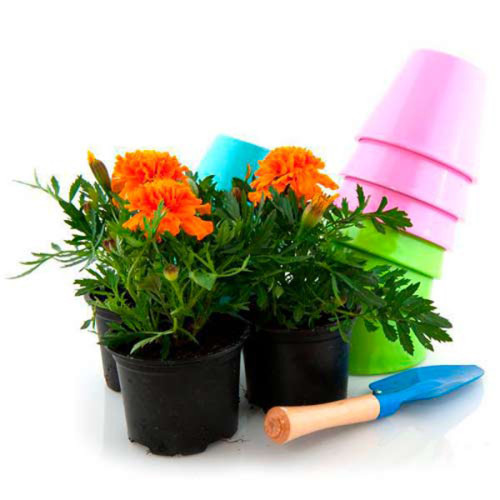
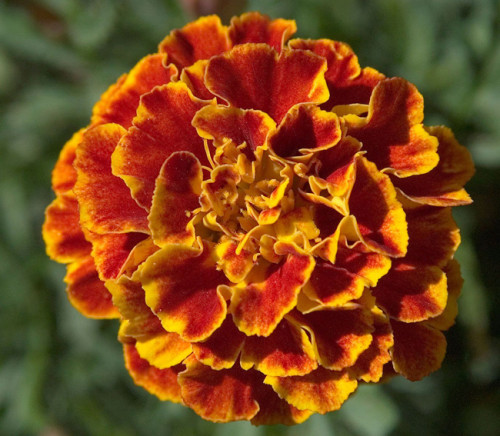

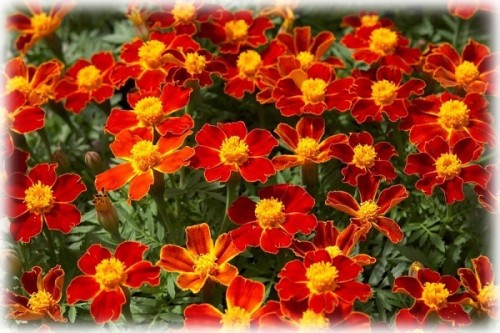
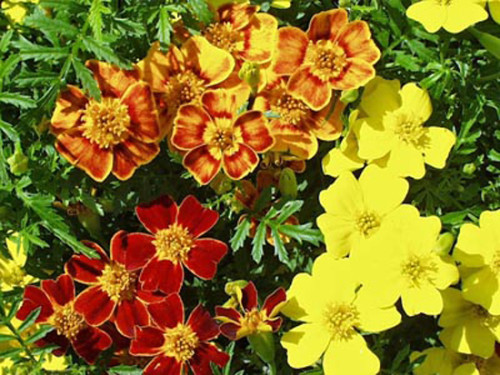
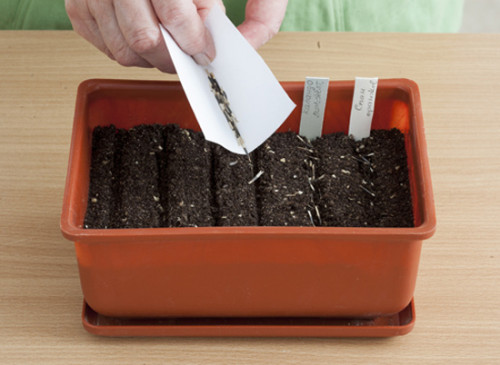
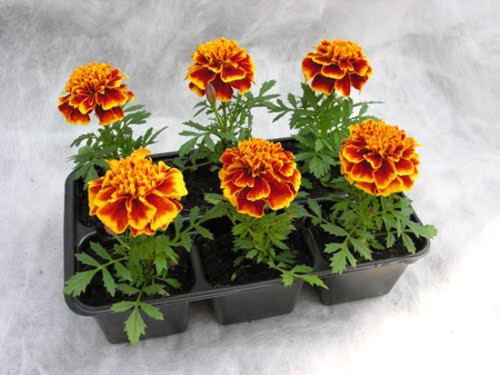
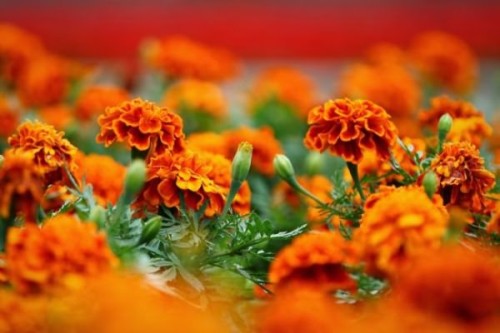
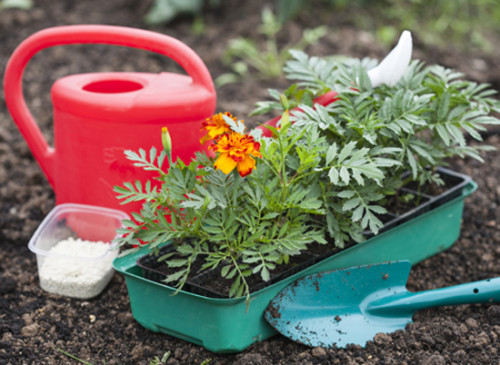


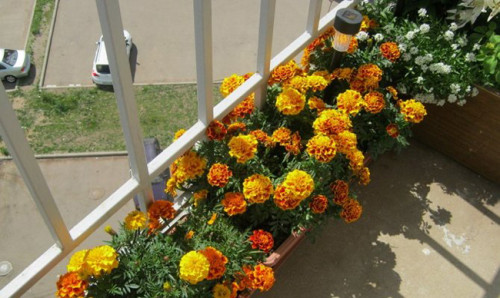

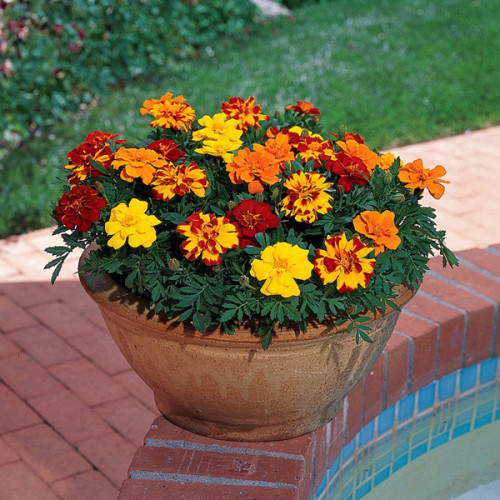












 Start a discussion ...
Start a discussion ...